Detailed Analysis of Mental Health Assessment and Recovery Care Plan
VerifiedAdded on 2020/07/23
|11
|3497
|45
Report
AI Summary
This report provides a comprehensive mental health assessment, encompassing various aspects of an individual's emotional and cognitive state. It begins with an introduction to mental health assessment, emphasizing its role in understanding a person's thoughts, memory, and overall well-being. The report then delves into specific areas, including level of consciousness, general appearance, behavior, mood, speech, thought content, intellectual performance, perception, judgment, and insight. Each section offers a clinical assessment, assessment questions, and analysis to provide a holistic view of the patient's condition. Furthermore, the report presents a Recovery Focused Nursing Care Plan, outlining consumer strengths, identified issues, and nursing interventions aimed at improving the patient's mental status. The plan includes goals, time frames, and responsible parties, emphasizing the importance of patient mood and mental status in their treatment and recovery. The report highlights how physicians and nurses can support patients through effective treatment and moral support, encouraging them to manage their emotions and maintain confidence throughout the recovery process.
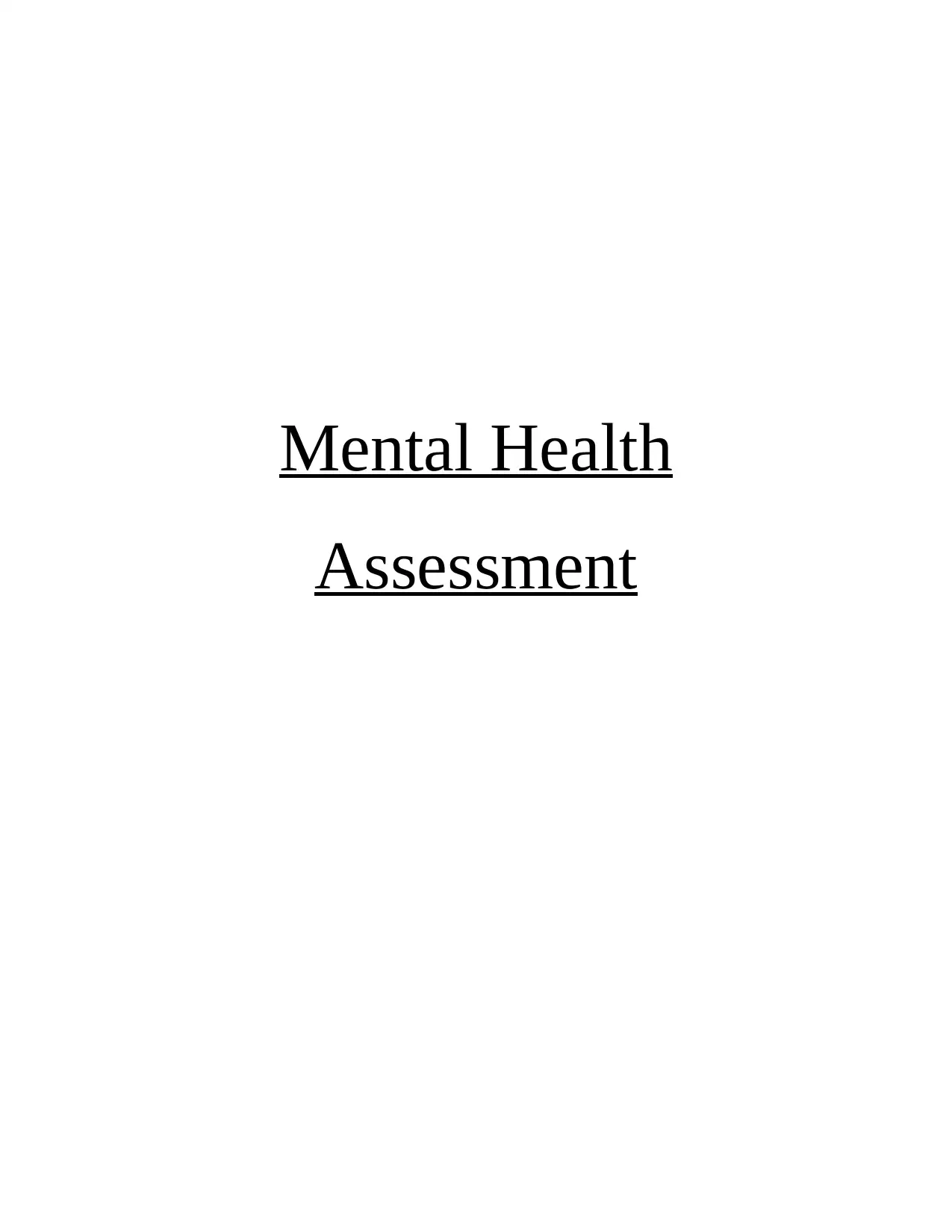
Mental Health
Assessment
Assessment
Paraphrase This Document
Need a fresh take? Get an instant paraphrase of this document with our AI Paraphraser

Table of Contents
INTRODUCTION...........................................................................................................................1
Section 1...........................................................................................................................................1
Section 2...........................................................................................................................................5
REFERENCES................................................................................................................................8
INTRODUCTION...........................................................................................................................1
Section 1...........................................................................................................................................1
Section 2...........................................................................................................................................5
REFERENCES................................................................................................................................8
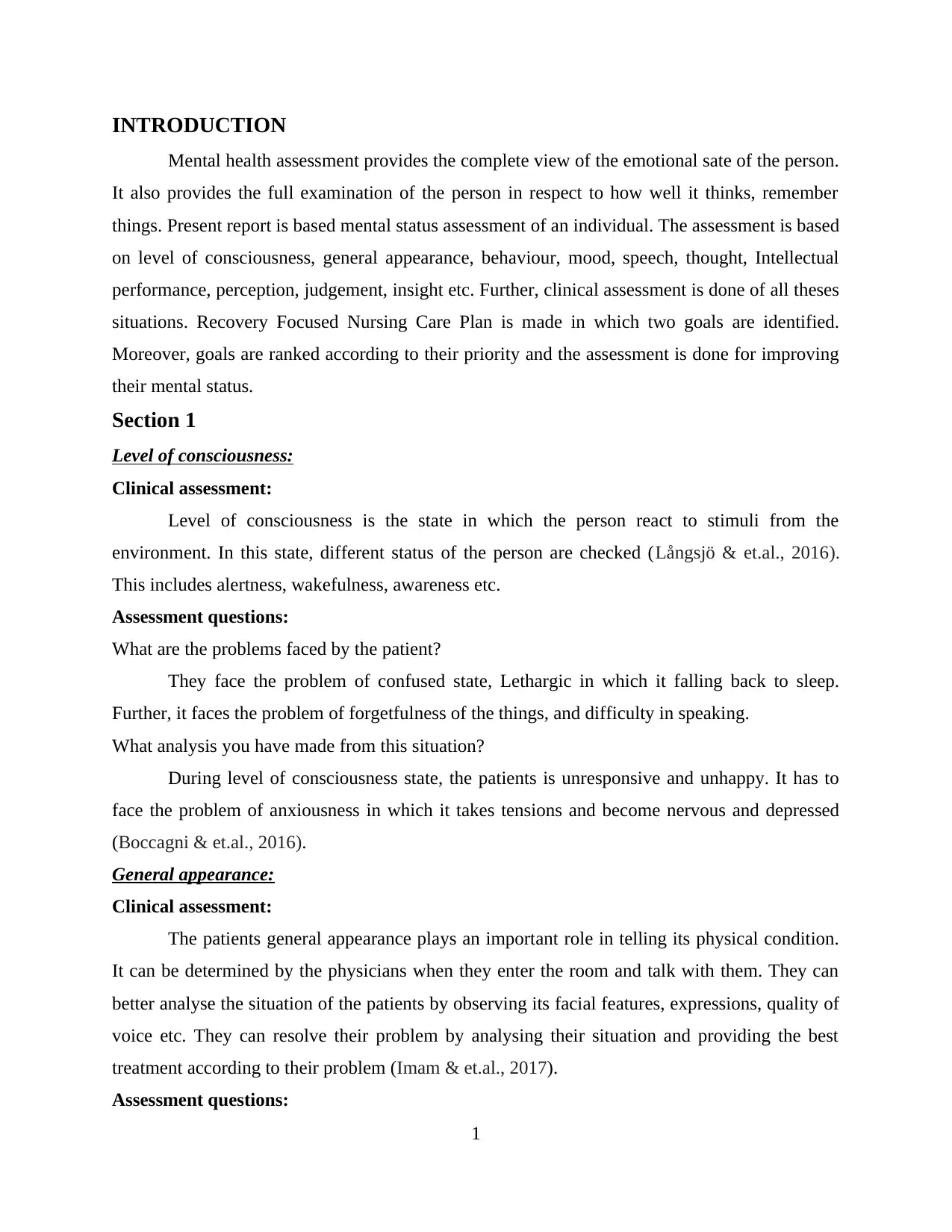
INTRODUCTION
Mental health assessment provides the complete view of the emotional sate of the person.
It also provides the full examination of the person in respect to how well it thinks, remember
things. Present report is based mental status assessment of an individual. The assessment is based
on level of consciousness, general appearance, behaviour, mood, speech, thought, Intellectual
performance, perception, judgement, insight etc. Further, clinical assessment is done of all theses
situations. Recovery Focused Nursing Care Plan is made in which two goals are identified.
Moreover, goals are ranked according to their priority and the assessment is done for improving
their mental status.
Section 1
Level of consciousness:
Clinical assessment:
Level of consciousness is the state in which the person react to stimuli from the
environment. In this state, different status of the person are checked (Långsjö & et.al., 2016).
This includes alertness, wakefulness, awareness etc.
Assessment questions:
What are the problems faced by the patient?
They face the problem of confused state, Lethargic in which it falling back to sleep.
Further, it faces the problem of forgetfulness of the things, and difficulty in speaking.
What analysis you have made from this situation?
During level of consciousness state, the patients is unresponsive and unhappy. It has to
face the problem of anxiousness in which it takes tensions and become nervous and depressed
(Boccagni & et.al., 2016).
General appearance:
Clinical assessment:
The patients general appearance plays an important role in telling its physical condition.
It can be determined by the physicians when they enter the room and talk with them. They can
better analyse the situation of the patients by observing its facial features, expressions, quality of
voice etc. They can resolve their problem by analysing their situation and providing the best
treatment according to their problem (Imam & et.al., 2017).
Assessment questions:
1
Mental health assessment provides the complete view of the emotional sate of the person.
It also provides the full examination of the person in respect to how well it thinks, remember
things. Present report is based mental status assessment of an individual. The assessment is based
on level of consciousness, general appearance, behaviour, mood, speech, thought, Intellectual
performance, perception, judgement, insight etc. Further, clinical assessment is done of all theses
situations. Recovery Focused Nursing Care Plan is made in which two goals are identified.
Moreover, goals are ranked according to their priority and the assessment is done for improving
their mental status.
Section 1
Level of consciousness:
Clinical assessment:
Level of consciousness is the state in which the person react to stimuli from the
environment. In this state, different status of the person are checked (Långsjö & et.al., 2016).
This includes alertness, wakefulness, awareness etc.
Assessment questions:
What are the problems faced by the patient?
They face the problem of confused state, Lethargic in which it falling back to sleep.
Further, it faces the problem of forgetfulness of the things, and difficulty in speaking.
What analysis you have made from this situation?
During level of consciousness state, the patients is unresponsive and unhappy. It has to
face the problem of anxiousness in which it takes tensions and become nervous and depressed
(Boccagni & et.al., 2016).
General appearance:
Clinical assessment:
The patients general appearance plays an important role in telling its physical condition.
It can be determined by the physicians when they enter the room and talk with them. They can
better analyse the situation of the patients by observing its facial features, expressions, quality of
voice etc. They can resolve their problem by analysing their situation and providing the best
treatment according to their problem (Imam & et.al., 2017).
Assessment questions:
1
⊘ This is a preview!⊘
Do you want full access?
Subscribe today to unlock all pages.

Trusted by 1+ million students worldwide
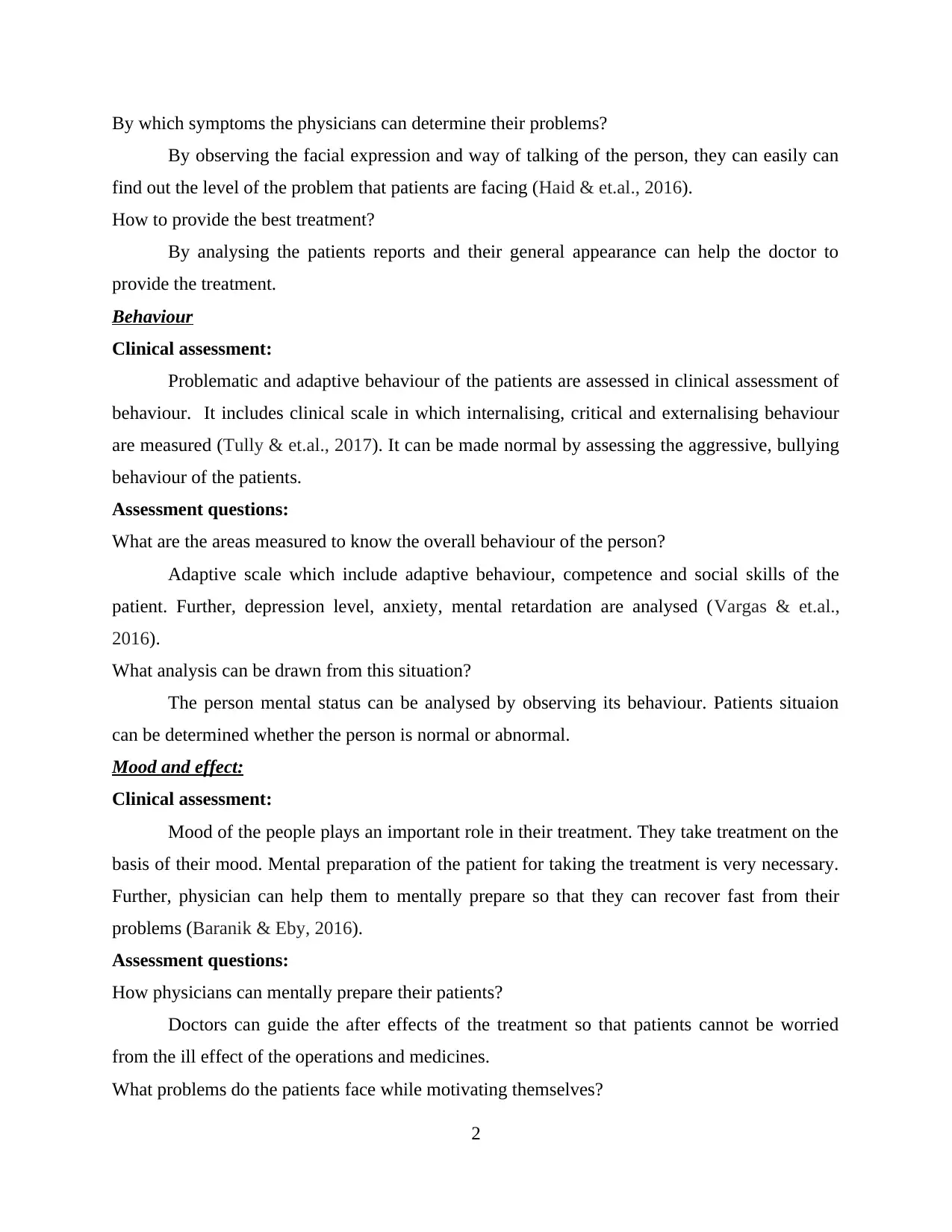
By which symptoms the physicians can determine their problems?
By observing the facial expression and way of talking of the person, they can easily can
find out the level of the problem that patients are facing (Haid & et.al., 2016).
How to provide the best treatment?
By analysing the patients reports and their general appearance can help the doctor to
provide the treatment.
Behaviour
Clinical assessment:
Problematic and adaptive behaviour of the patients are assessed in clinical assessment of
behaviour. It includes clinical scale in which internalising, critical and externalising behaviour
are measured (Tully & et.al., 2017). It can be made normal by assessing the aggressive, bullying
behaviour of the patients.
Assessment questions:
What are the areas measured to know the overall behaviour of the person?
Adaptive scale which include adaptive behaviour, competence and social skills of the
patient. Further, depression level, anxiety, mental retardation are analysed (Vargas & et.al.,
2016).
What analysis can be drawn from this situation?
The person mental status can be analysed by observing its behaviour. Patients situaion
can be determined whether the person is normal or abnormal.
Mood and effect:
Clinical assessment:
Mood of the people plays an important role in their treatment. They take treatment on the
basis of their mood. Mental preparation of the patient for taking the treatment is very necessary.
Further, physician can help them to mentally prepare so that they can recover fast from their
problems (Baranik & Eby, 2016).
Assessment questions:
How physicians can mentally prepare their patients?
Doctors can guide the after effects of the treatment so that patients cannot be worried
from the ill effect of the operations and medicines.
What problems do the patients face while motivating themselves?
2
By observing the facial expression and way of talking of the person, they can easily can
find out the level of the problem that patients are facing (Haid & et.al., 2016).
How to provide the best treatment?
By analysing the patients reports and their general appearance can help the doctor to
provide the treatment.
Behaviour
Clinical assessment:
Problematic and adaptive behaviour of the patients are assessed in clinical assessment of
behaviour. It includes clinical scale in which internalising, critical and externalising behaviour
are measured (Tully & et.al., 2017). It can be made normal by assessing the aggressive, bullying
behaviour of the patients.
Assessment questions:
What are the areas measured to know the overall behaviour of the person?
Adaptive scale which include adaptive behaviour, competence and social skills of the
patient. Further, depression level, anxiety, mental retardation are analysed (Vargas & et.al.,
2016).
What analysis can be drawn from this situation?
The person mental status can be analysed by observing its behaviour. Patients situaion
can be determined whether the person is normal or abnormal.
Mood and effect:
Clinical assessment:
Mood of the people plays an important role in their treatment. They take treatment on the
basis of their mood. Mental preparation of the patient for taking the treatment is very necessary.
Further, physician can help them to mentally prepare so that they can recover fast from their
problems (Baranik & Eby, 2016).
Assessment questions:
How physicians can mentally prepare their patients?
Doctors can guide the after effects of the treatment so that patients cannot be worried
from the ill effect of the operations and medicines.
What problems do the patients face while motivating themselves?
2
Paraphrase This Document
Need a fresh take? Get an instant paraphrase of this document with our AI Paraphraser
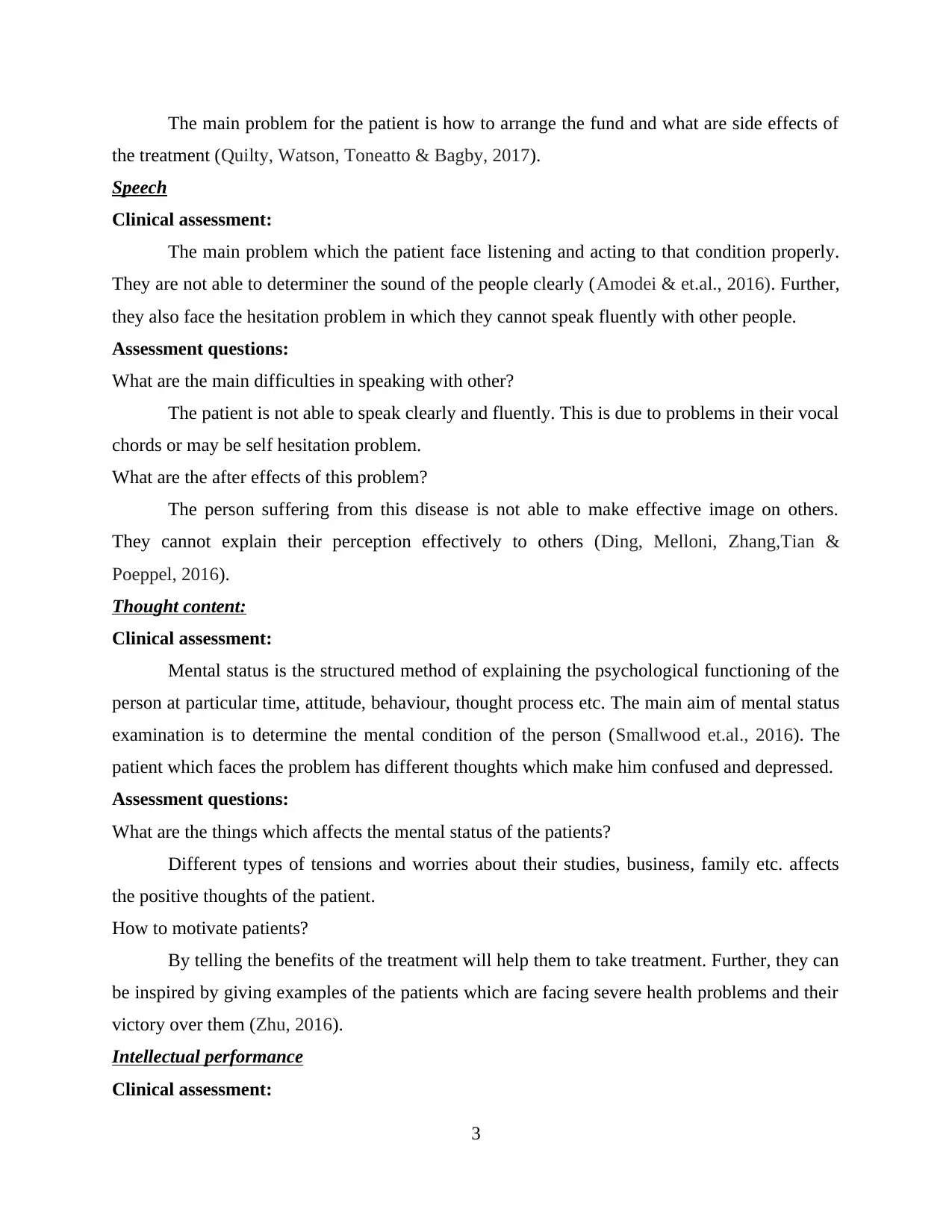
The main problem for the patient is how to arrange the fund and what are side effects of
the treatment (Quilty, Watson, Toneatto & Bagby, 2017).
Speech
Clinical assessment:
The main problem which the patient face listening and acting to that condition properly.
They are not able to determiner the sound of the people clearly (Amodei & et.al., 2016). Further,
they also face the hesitation problem in which they cannot speak fluently with other people.
Assessment questions:
What are the main difficulties in speaking with other?
The patient is not able to speak clearly and fluently. This is due to problems in their vocal
chords or may be self hesitation problem.
What are the after effects of this problem?
The person suffering from this disease is not able to make effective image on others.
They cannot explain their perception effectively to others (Ding, Melloni, Zhang,Tian &
Poeppel, 2016).
Thought content:
Clinical assessment:
Mental status is the structured method of explaining the psychological functioning of the
person at particular time, attitude, behaviour, thought process etc. The main aim of mental status
examination is to determine the mental condition of the person (Smallwood et.al., 2016). The
patient which faces the problem has different thoughts which make him confused and depressed.
Assessment questions:
What are the things which affects the mental status of the patients?
Different types of tensions and worries about their studies, business, family etc. affects
the positive thoughts of the patient.
How to motivate patients?
By telling the benefits of the treatment will help them to take treatment. Further, they can
be inspired by giving examples of the patients which are facing severe health problems and their
victory over them (Zhu, 2016).
Intellectual performance
Clinical assessment:
3
the treatment (Quilty, Watson, Toneatto & Bagby, 2017).
Speech
Clinical assessment:
The main problem which the patient face listening and acting to that condition properly.
They are not able to determiner the sound of the people clearly (Amodei & et.al., 2016). Further,
they also face the hesitation problem in which they cannot speak fluently with other people.
Assessment questions:
What are the main difficulties in speaking with other?
The patient is not able to speak clearly and fluently. This is due to problems in their vocal
chords or may be self hesitation problem.
What are the after effects of this problem?
The person suffering from this disease is not able to make effective image on others.
They cannot explain their perception effectively to others (Ding, Melloni, Zhang,Tian &
Poeppel, 2016).
Thought content:
Clinical assessment:
Mental status is the structured method of explaining the psychological functioning of the
person at particular time, attitude, behaviour, thought process etc. The main aim of mental status
examination is to determine the mental condition of the person (Smallwood et.al., 2016). The
patient which faces the problem has different thoughts which make him confused and depressed.
Assessment questions:
What are the things which affects the mental status of the patients?
Different types of tensions and worries about their studies, business, family etc. affects
the positive thoughts of the patient.
How to motivate patients?
By telling the benefits of the treatment will help them to take treatment. Further, they can
be inspired by giving examples of the patients which are facing severe health problems and their
victory over them (Zhu, 2016).
Intellectual performance
Clinical assessment:
3
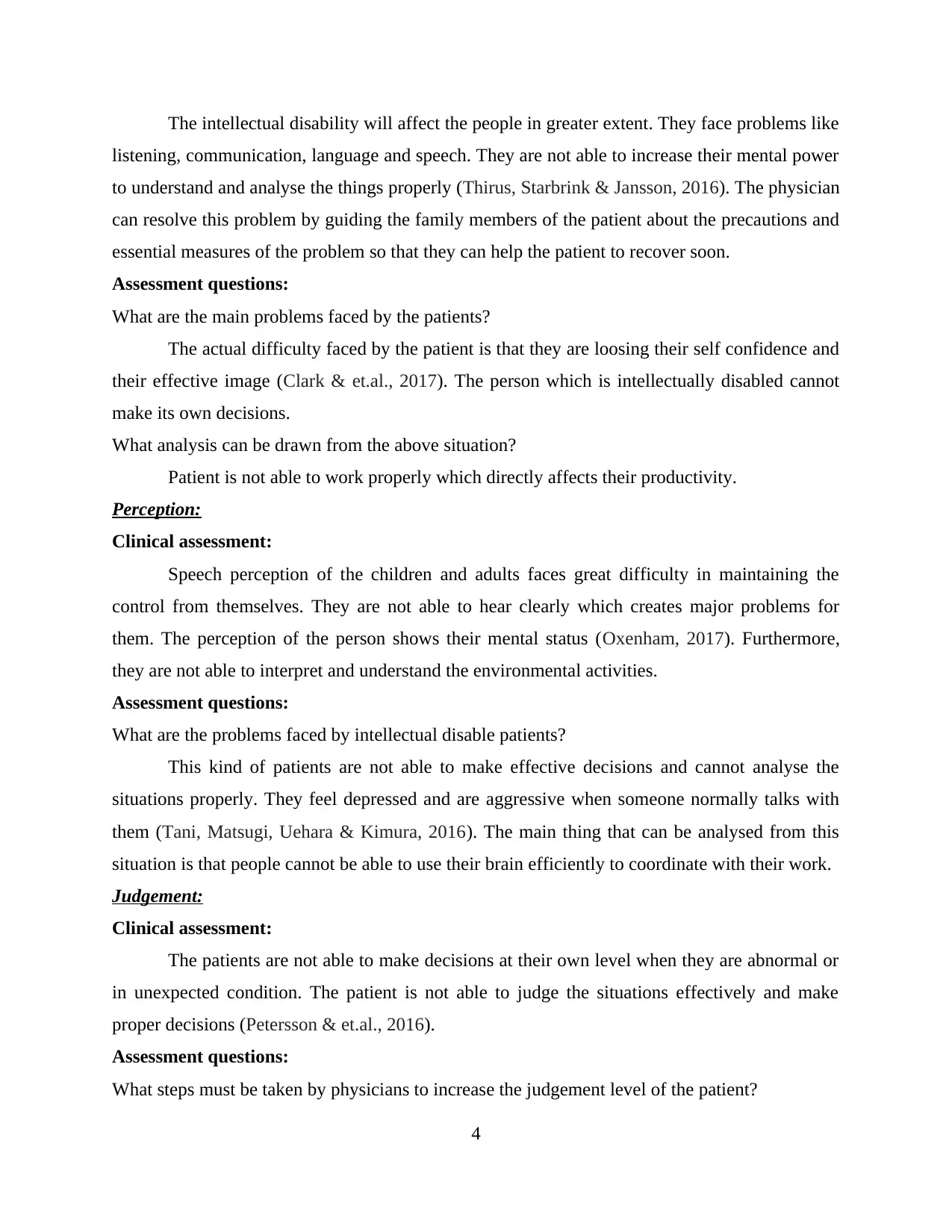
The intellectual disability will affect the people in greater extent. They face problems like
listening, communication, language and speech. They are not able to increase their mental power
to understand and analyse the things properly (Thirus, Starbrink & Jansson, 2016). The physician
can resolve this problem by guiding the family members of the patient about the precautions and
essential measures of the problem so that they can help the patient to recover soon.
Assessment questions:
What are the main problems faced by the patients?
The actual difficulty faced by the patient is that they are loosing their self confidence and
their effective image (Clark & et.al., 2017). The person which is intellectually disabled cannot
make its own decisions.
What analysis can be drawn from the above situation?
Patient is not able to work properly which directly affects their productivity.
Perception:
Clinical assessment:
Speech perception of the children and adults faces great difficulty in maintaining the
control from themselves. They are not able to hear clearly which creates major problems for
them. The perception of the person shows their mental status (Oxenham, 2017). Furthermore,
they are not able to interpret and understand the environmental activities.
Assessment questions:
What are the problems faced by intellectual disable patients?
This kind of patients are not able to make effective decisions and cannot analyse the
situations properly. They feel depressed and are aggressive when someone normally talks with
them (Tani, Matsugi, Uehara & Kimura, 2016). The main thing that can be analysed from this
situation is that people cannot be able to use their brain efficiently to coordinate with their work.
Judgement:
Clinical assessment:
The patients are not able to make decisions at their own level when they are abnormal or
in unexpected condition. The patient is not able to judge the situations effectively and make
proper decisions (Petersson & et.al., 2016).
Assessment questions:
What steps must be taken by physicians to increase the judgement level of the patient?
4
listening, communication, language and speech. They are not able to increase their mental power
to understand and analyse the things properly (Thirus, Starbrink & Jansson, 2016). The physician
can resolve this problem by guiding the family members of the patient about the precautions and
essential measures of the problem so that they can help the patient to recover soon.
Assessment questions:
What are the main problems faced by the patients?
The actual difficulty faced by the patient is that they are loosing their self confidence and
their effective image (Clark & et.al., 2017). The person which is intellectually disabled cannot
make its own decisions.
What analysis can be drawn from the above situation?
Patient is not able to work properly which directly affects their productivity.
Perception:
Clinical assessment:
Speech perception of the children and adults faces great difficulty in maintaining the
control from themselves. They are not able to hear clearly which creates major problems for
them. The perception of the person shows their mental status (Oxenham, 2017). Furthermore,
they are not able to interpret and understand the environmental activities.
Assessment questions:
What are the problems faced by intellectual disable patients?
This kind of patients are not able to make effective decisions and cannot analyse the
situations properly. They feel depressed and are aggressive when someone normally talks with
them (Tani, Matsugi, Uehara & Kimura, 2016). The main thing that can be analysed from this
situation is that people cannot be able to use their brain efficiently to coordinate with their work.
Judgement:
Clinical assessment:
The patients are not able to make decisions at their own level when they are abnormal or
in unexpected condition. The patient is not able to judge the situations effectively and make
proper decisions (Petersson & et.al., 2016).
Assessment questions:
What steps must be taken by physicians to increase the judgement level of the patient?
4
⊘ This is a preview!⊘
Do you want full access?
Subscribe today to unlock all pages.

Trusted by 1+ million students worldwide
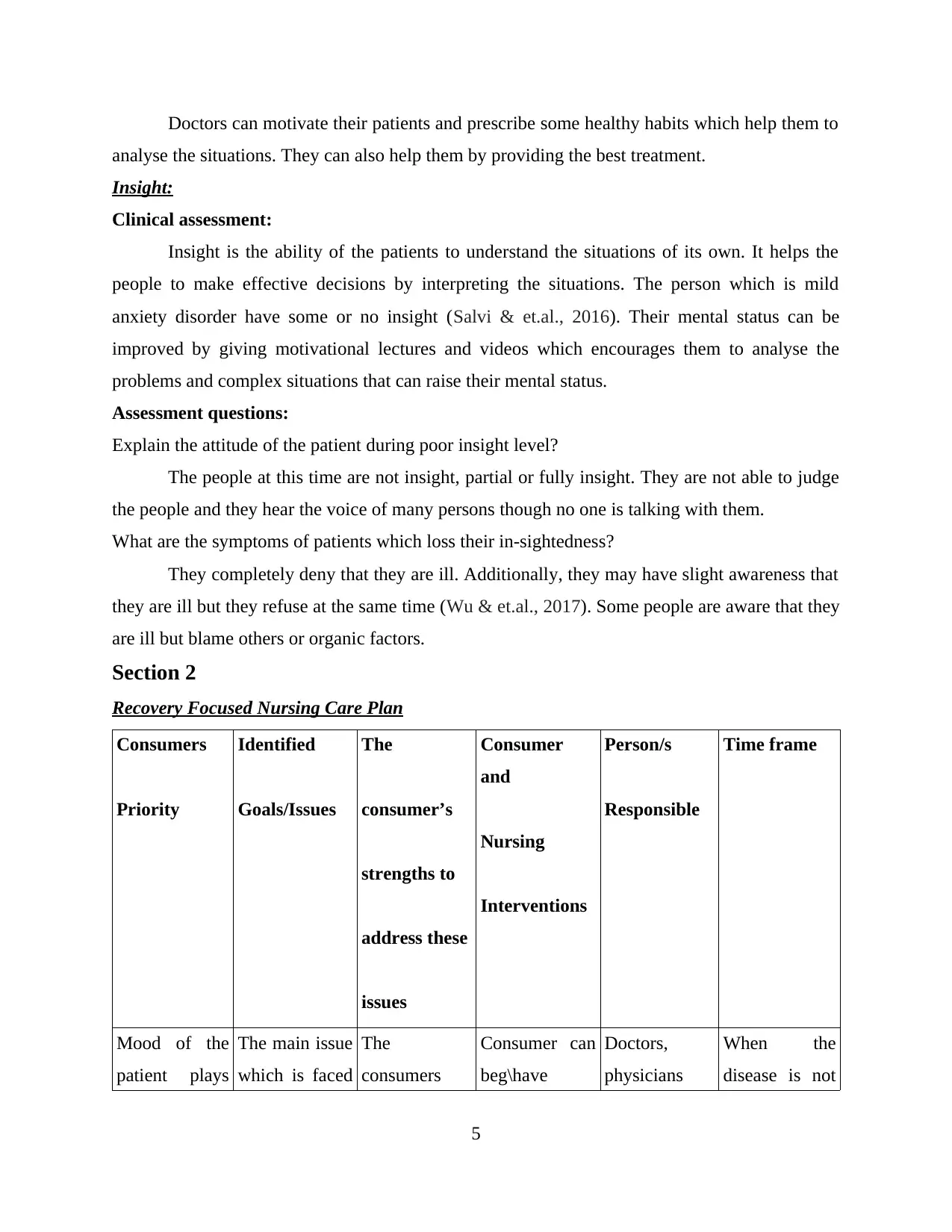
Doctors can motivate their patients and prescribe some healthy habits which help them to
analyse the situations. They can also help them by providing the best treatment.
Insight:
Clinical assessment:
Insight is the ability of the patients to understand the situations of its own. It helps the
people to make effective decisions by interpreting the situations. The person which is mild
anxiety disorder have some or no insight (Salvi & et.al., 2016). Their mental status can be
improved by giving motivational lectures and videos which encourages them to analyse the
problems and complex situations that can raise their mental status.
Assessment questions:
Explain the attitude of the patient during poor insight level?
The people at this time are not insight, partial or fully insight. They are not able to judge
the people and they hear the voice of many persons though no one is talking with them.
What are the symptoms of patients which loss their in-sightedness?
They completely deny that they are ill. Additionally, they may have slight awareness that
they are ill but they refuse at the same time (Wu & et.al., 2017). Some people are aware that they
are ill but blame others or organic factors.
Section 2
Recovery Focused Nursing Care Plan
Consumers
Priority
Identified
Goals/Issues
The
consumer’s
strengths to
address these
issues
Consumer
and
Nursing
Interventions
Person/s
Responsible
Time frame
Mood of the
patient plays
The main issue
which is faced
The
consumers
Consumer can
beg\have
Doctors,
physicians
When the
disease is not
5
analyse the situations. They can also help them by providing the best treatment.
Insight:
Clinical assessment:
Insight is the ability of the patients to understand the situations of its own. It helps the
people to make effective decisions by interpreting the situations. The person which is mild
anxiety disorder have some or no insight (Salvi & et.al., 2016). Their mental status can be
improved by giving motivational lectures and videos which encourages them to analyse the
problems and complex situations that can raise their mental status.
Assessment questions:
Explain the attitude of the patient during poor insight level?
The people at this time are not insight, partial or fully insight. They are not able to judge
the people and they hear the voice of many persons though no one is talking with them.
What are the symptoms of patients which loss their in-sightedness?
They completely deny that they are ill. Additionally, they may have slight awareness that
they are ill but they refuse at the same time (Wu & et.al., 2017). Some people are aware that they
are ill but blame others or organic factors.
Section 2
Recovery Focused Nursing Care Plan
Consumers
Priority
Identified
Goals/Issues
The
consumer’s
strengths to
address these
issues
Consumer
and
Nursing
Interventions
Person/s
Responsible
Time frame
Mood of the
patient plays
The main issue
which is faced
The
consumers
Consumer can
beg\have
Doctors,
physicians
When the
disease is not
5
Paraphrase This Document
Need a fresh take? Get an instant paraphrase of this document with our AI Paraphraser
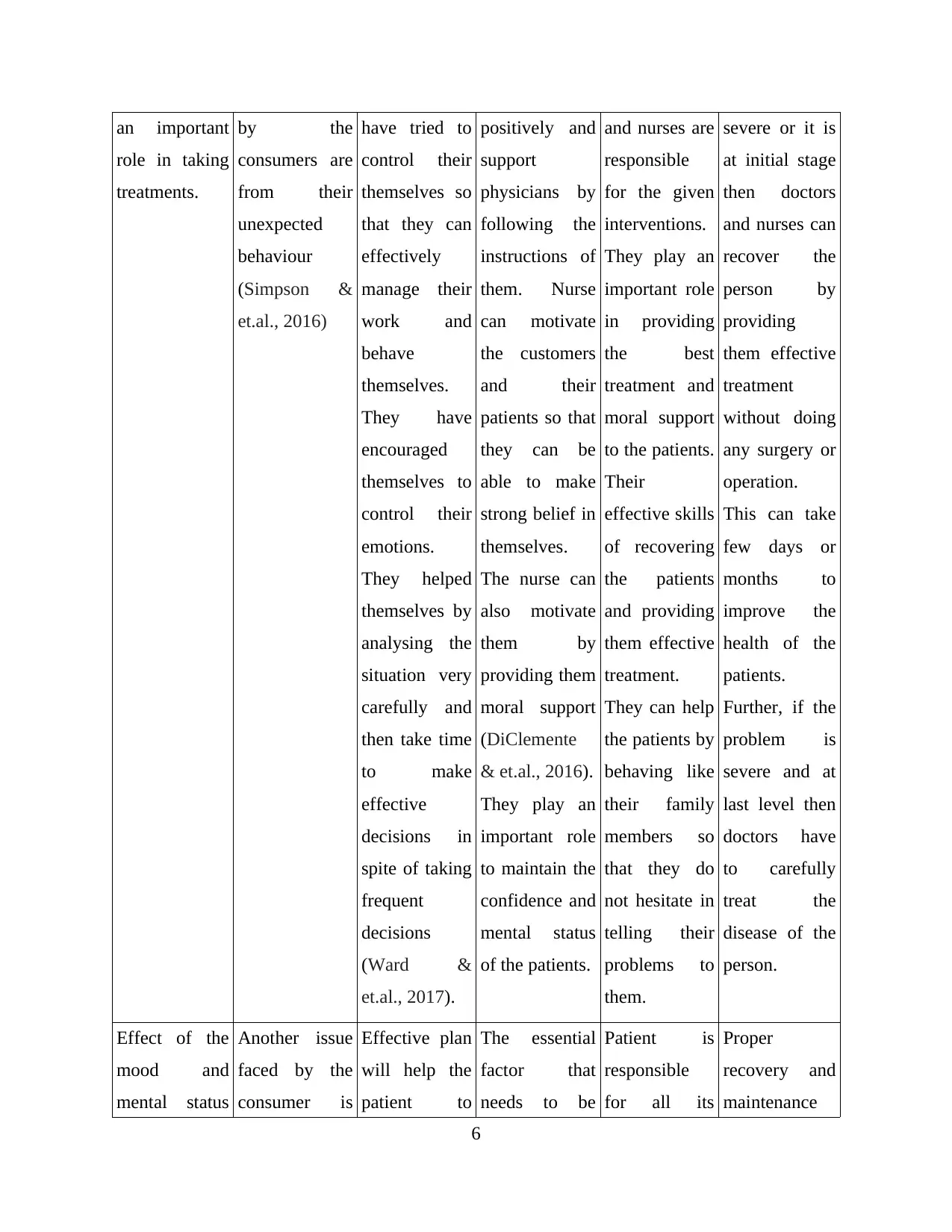
an important
role in taking
treatments.
by the
consumers are
from their
unexpected
behaviour
(Simpson &
et.al., 2016)
have tried to
control their
themselves so
that they can
effectively
manage their
work and
behave
themselves.
They have
encouraged
themselves to
control their
emotions.
They helped
themselves by
analysing the
situation very
carefully and
then take time
to make
effective
decisions in
spite of taking
frequent
decisions
(Ward &
et.al., 2017).
positively and
support
physicians by
following the
instructions of
them. Nurse
can motivate
the customers
and their
patients so that
they can be
able to make
strong belief in
themselves.
The nurse can
also motivate
them by
providing them
moral support
(DiClemente
& et.al., 2016).
They play an
important role
to maintain the
confidence and
mental status
of the patients.
and nurses are
responsible
for the given
interventions.
They play an
important role
in providing
the best
treatment and
moral support
to the patients.
Their
effective skills
of recovering
the patients
and providing
them effective
treatment.
They can help
the patients by
behaving like
their family
members so
that they do
not hesitate in
telling their
problems to
them.
severe or it is
at initial stage
then doctors
and nurses can
recover the
person by
providing
them effective
treatment
without doing
any surgery or
operation.
This can take
few days or
months to
improve the
health of the
patients.
Further, if the
problem is
severe and at
last level then
doctors have
to carefully
treat the
disease of the
person.
Effect of the
mood and
mental status
Another issue
faced by the
consumer is
Effective plan
will help the
patient to
The essential
factor that
needs to be
Patient is
responsible
for all its
Proper
recovery and
maintenance
6
role in taking
treatments.
by the
consumers are
from their
unexpected
behaviour
(Simpson &
et.al., 2016)
have tried to
control their
themselves so
that they can
effectively
manage their
work and
behave
themselves.
They have
encouraged
themselves to
control their
emotions.
They helped
themselves by
analysing the
situation very
carefully and
then take time
to make
effective
decisions in
spite of taking
frequent
decisions
(Ward &
et.al., 2017).
positively and
support
physicians by
following the
instructions of
them. Nurse
can motivate
the customers
and their
patients so that
they can be
able to make
strong belief in
themselves.
The nurse can
also motivate
them by
providing them
moral support
(DiClemente
& et.al., 2016).
They play an
important role
to maintain the
confidence and
mental status
of the patients.
and nurses are
responsible
for the given
interventions.
They play an
important role
in providing
the best
treatment and
moral support
to the patients.
Their
effective skills
of recovering
the patients
and providing
them effective
treatment.
They can help
the patients by
behaving like
their family
members so
that they do
not hesitate in
telling their
problems to
them.
severe or it is
at initial stage
then doctors
and nurses can
recover the
person by
providing
them effective
treatment
without doing
any surgery or
operation.
This can take
few days or
months to
improve the
health of the
patients.
Further, if the
problem is
severe and at
last level then
doctors have
to carefully
treat the
disease of the
person.
Effect of the
mood and
mental status
Another issue
faced by the
consumer is
Effective plan
will help the
patient to
The essential
factor that
needs to be
Patient is
responsible
for all its
Proper
recovery and
maintenance
6
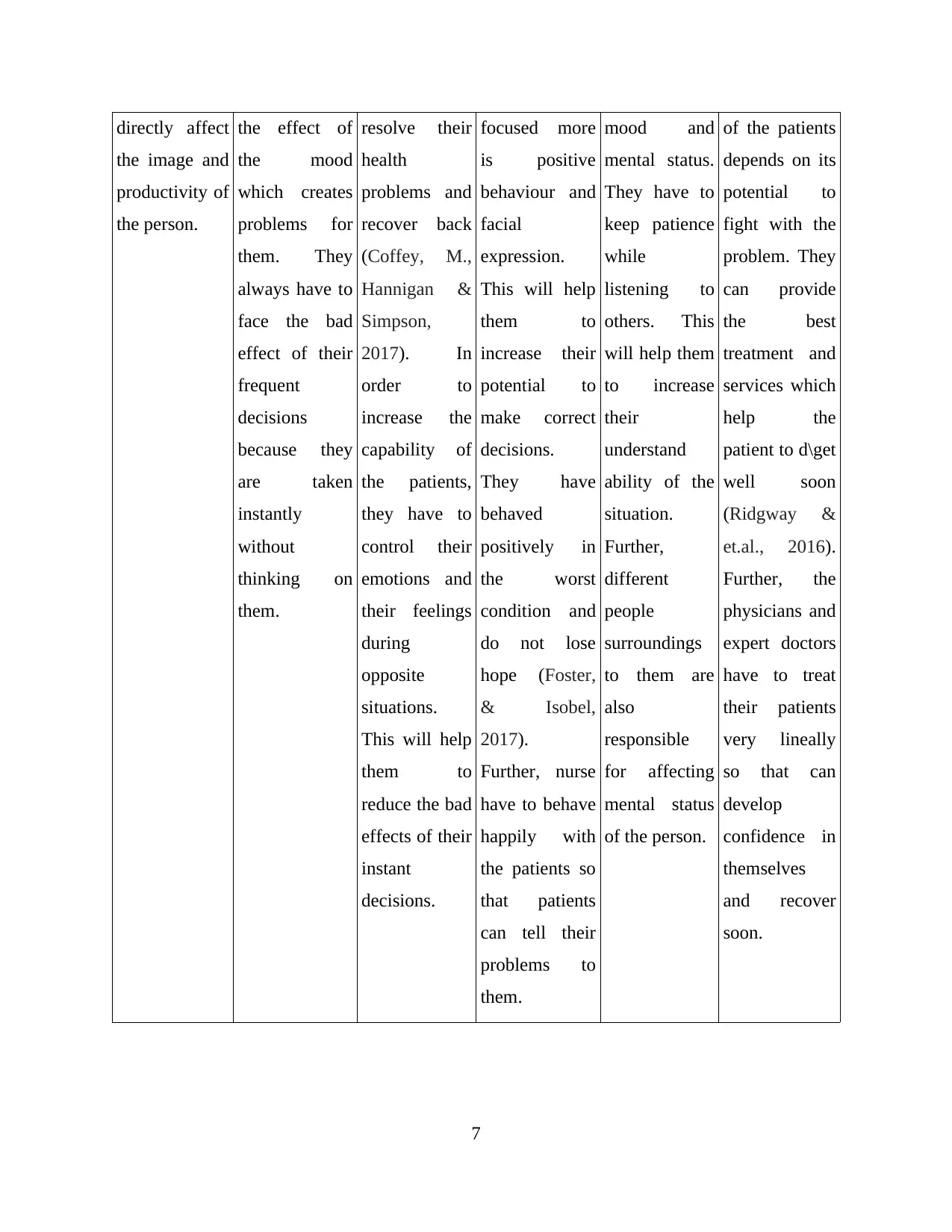
directly affect
the image and
productivity of
the person.
the effect of
the mood
which creates
problems for
them. They
always have to
face the bad
effect of their
frequent
decisions
because they
are taken
instantly
without
thinking on
them.
resolve their
health
problems and
recover back
(Coffey, M.,
Hannigan &
Simpson,
2017). In
order to
increase the
capability of
the patients,
they have to
control their
emotions and
their feelings
during
opposite
situations.
This will help
them to
reduce the bad
effects of their
instant
decisions.
focused more
is positive
behaviour and
facial
expression.
This will help
them to
increase their
potential to
make correct
decisions.
They have
behaved
positively in
the worst
condition and
do not lose
hope (Foster,
& Isobel,
2017).
Further, nurse
have to behave
happily with
the patients so
that patients
can tell their
problems to
them.
mood and
mental status.
They have to
keep patience
while
listening to
others. This
will help them
to increase
their
understand
ability of the
situation.
Further,
different
people
surroundings
to them are
also
responsible
for affecting
mental status
of the person.
of the patients
depends on its
potential to
fight with the
problem. They
can provide
the best
treatment and
services which
help the
patient to d\get
well soon
(Ridgway &
et.al., 2016).
Further, the
physicians and
expert doctors
have to treat
their patients
very lineally
so that can
develop
confidence in
themselves
and recover
soon.
7
the image and
productivity of
the person.
the effect of
the mood
which creates
problems for
them. They
always have to
face the bad
effect of their
frequent
decisions
because they
are taken
instantly
without
thinking on
them.
resolve their
health
problems and
recover back
(Coffey, M.,
Hannigan &
Simpson,
2017). In
order to
increase the
capability of
the patients,
they have to
control their
emotions and
their feelings
during
opposite
situations.
This will help
them to
reduce the bad
effects of their
instant
decisions.
focused more
is positive
behaviour and
facial
expression.
This will help
them to
increase their
potential to
make correct
decisions.
They have
behaved
positively in
the worst
condition and
do not lose
hope (Foster,
& Isobel,
2017).
Further, nurse
have to behave
happily with
the patients so
that patients
can tell their
problems to
them.
mood and
mental status.
They have to
keep patience
while
listening to
others. This
will help them
to increase
their
understand
ability of the
situation.
Further,
different
people
surroundings
to them are
also
responsible
for affecting
mental status
of the person.
of the patients
depends on its
potential to
fight with the
problem. They
can provide
the best
treatment and
services which
help the
patient to d\get
well soon
(Ridgway &
et.al., 2016).
Further, the
physicians and
expert doctors
have to treat
their patients
very lineally
so that can
develop
confidence in
themselves
and recover
soon.
7
⊘ This is a preview!⊘
Do you want full access?
Subscribe today to unlock all pages.

Trusted by 1+ million students worldwide
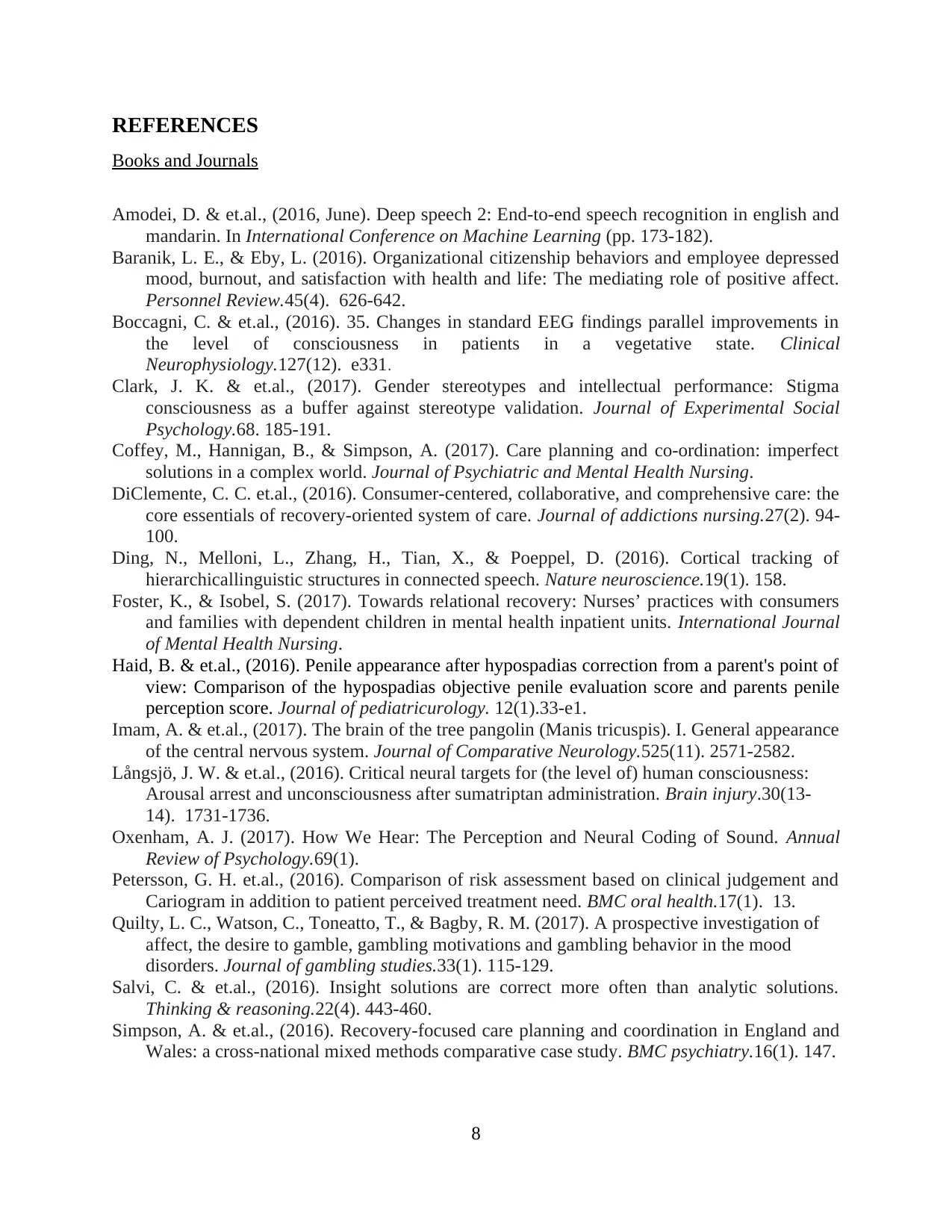
REFERENCES
Books and Journals
Amodei, D. & et.al., (2016, June). Deep speech 2: End-to-end speech recognition in english and
mandarin. In International Conference on Machine Learning (pp. 173-182).
Baranik, L. E., & Eby, L. (2016). Organizational citizenship behaviors and employee depressed
mood, burnout, and satisfaction with health and life: The mediating role of positive affect.
Personnel Review.45(4). 626-642.
Boccagni, C. & et.al., (2016). 35. Changes in standard EEG findings parallel improvements in
the level of consciousness in patients in a vegetative state. Clinical
Neurophysiology.127(12). e331.
Clark, J. K. & et.al., (2017). Gender stereotypes and intellectual performance: Stigma
consciousness as a buffer against stereotype validation. Journal of Experimental Social
Psychology.68. 185-191.
Coffey, M., Hannigan, B., & Simpson, A. (2017). Care planning and co‐ordination: imperfect
solutions in a complex world. Journal of Psychiatric and Mental Health Nursing.
DiClemente, C. C. et.al., (2016). Consumer-centered, collaborative, and comprehensive care: the
core essentials of recovery-oriented system of care. Journal of addictions nursing.27(2). 94-
100.
Ding, N., Melloni, L., Zhang, H., Tian, X., & Poeppel, D. (2016). Cortical tracking of
hierarchicallinguistic structures in connected speech. Nature neuroscience.19(1). 158.
Foster, K., & Isobel, S. (2017). Towards relational recovery: Nurses’ practices with consumers
and families with dependent children in mental health inpatient units. International Journal
of Mental Health Nursing.
Haid, B. & et.al., (2016). Penile appearance after hypospadias correction from a parent's point of
view: Comparison of the hypospadias objective penile evaluation score and parents penile
perception score. Journal of pediatricurology. 12(1).33-e1.
Imam, A. & et.al., (2017). The brain of the tree pangolin (Manis tricuspis). I. General appearance
of the central nervous system. Journal of Comparative Neurology.525(11). 2571-2582.
Långsjö, J. W. & et.al., (2016). Critical neural targets for (the level of) human consciousness:
Arousal arrest and unconsciousness after sumatriptan administration. Brain injury.30(13-
14). 1731-1736.
Oxenham, A. J. (2017). How We Hear: The Perception and Neural Coding of Sound. Annual
Review of Psychology.69(1).
Petersson, G. H. et.al., (2016). Comparison of risk assessment based on clinical judgement and
Cariogram in addition to patient perceived treatment need. BMC oral health.17(1). 13.
Quilty, L. C., Watson, C., Toneatto, T., & Bagby, R. M. (2017). A prospective investigation of
affect, the desire to gamble, gambling motivations and gambling behavior in the mood
disorders. Journal of gambling studies.33(1). 115-129.
Salvi, C. & et.al., (2016). Insight solutions are correct more often than analytic solutions.
Thinking & reasoning.22(4). 443-460.
Simpson, A. & et.al., (2016). Recovery-focused care planning and coordination in England and
Wales: a cross-national mixed methods comparative case study. BMC psychiatry.16(1). 147.
8
Books and Journals
Amodei, D. & et.al., (2016, June). Deep speech 2: End-to-end speech recognition in english and
mandarin. In International Conference on Machine Learning (pp. 173-182).
Baranik, L. E., & Eby, L. (2016). Organizational citizenship behaviors and employee depressed
mood, burnout, and satisfaction with health and life: The mediating role of positive affect.
Personnel Review.45(4). 626-642.
Boccagni, C. & et.al., (2016). 35. Changes in standard EEG findings parallel improvements in
the level of consciousness in patients in a vegetative state. Clinical
Neurophysiology.127(12). e331.
Clark, J. K. & et.al., (2017). Gender stereotypes and intellectual performance: Stigma
consciousness as a buffer against stereotype validation. Journal of Experimental Social
Psychology.68. 185-191.
Coffey, M., Hannigan, B., & Simpson, A. (2017). Care planning and co‐ordination: imperfect
solutions in a complex world. Journal of Psychiatric and Mental Health Nursing.
DiClemente, C. C. et.al., (2016). Consumer-centered, collaborative, and comprehensive care: the
core essentials of recovery-oriented system of care. Journal of addictions nursing.27(2). 94-
100.
Ding, N., Melloni, L., Zhang, H., Tian, X., & Poeppel, D. (2016). Cortical tracking of
hierarchicallinguistic structures in connected speech. Nature neuroscience.19(1). 158.
Foster, K., & Isobel, S. (2017). Towards relational recovery: Nurses’ practices with consumers
and families with dependent children in mental health inpatient units. International Journal
of Mental Health Nursing.
Haid, B. & et.al., (2016). Penile appearance after hypospadias correction from a parent's point of
view: Comparison of the hypospadias objective penile evaluation score and parents penile
perception score. Journal of pediatricurology. 12(1).33-e1.
Imam, A. & et.al., (2017). The brain of the tree pangolin (Manis tricuspis). I. General appearance
of the central nervous system. Journal of Comparative Neurology.525(11). 2571-2582.
Långsjö, J. W. & et.al., (2016). Critical neural targets for (the level of) human consciousness:
Arousal arrest and unconsciousness after sumatriptan administration. Brain injury.30(13-
14). 1731-1736.
Oxenham, A. J. (2017). How We Hear: The Perception and Neural Coding of Sound. Annual
Review of Psychology.69(1).
Petersson, G. H. et.al., (2016). Comparison of risk assessment based on clinical judgement and
Cariogram in addition to patient perceived treatment need. BMC oral health.17(1). 13.
Quilty, L. C., Watson, C., Toneatto, T., & Bagby, R. M. (2017). A prospective investigation of
affect, the desire to gamble, gambling motivations and gambling behavior in the mood
disorders. Journal of gambling studies.33(1). 115-129.
Salvi, C. & et.al., (2016). Insight solutions are correct more often than analytic solutions.
Thinking & reasoning.22(4). 443-460.
Simpson, A. & et.al., (2016). Recovery-focused care planning and coordination in England and
Wales: a cross-national mixed methods comparative case study. BMC psychiatry.16(1). 147.
8
Paraphrase This Document
Need a fresh take? Get an instant paraphrase of this document with our AI Paraphraser
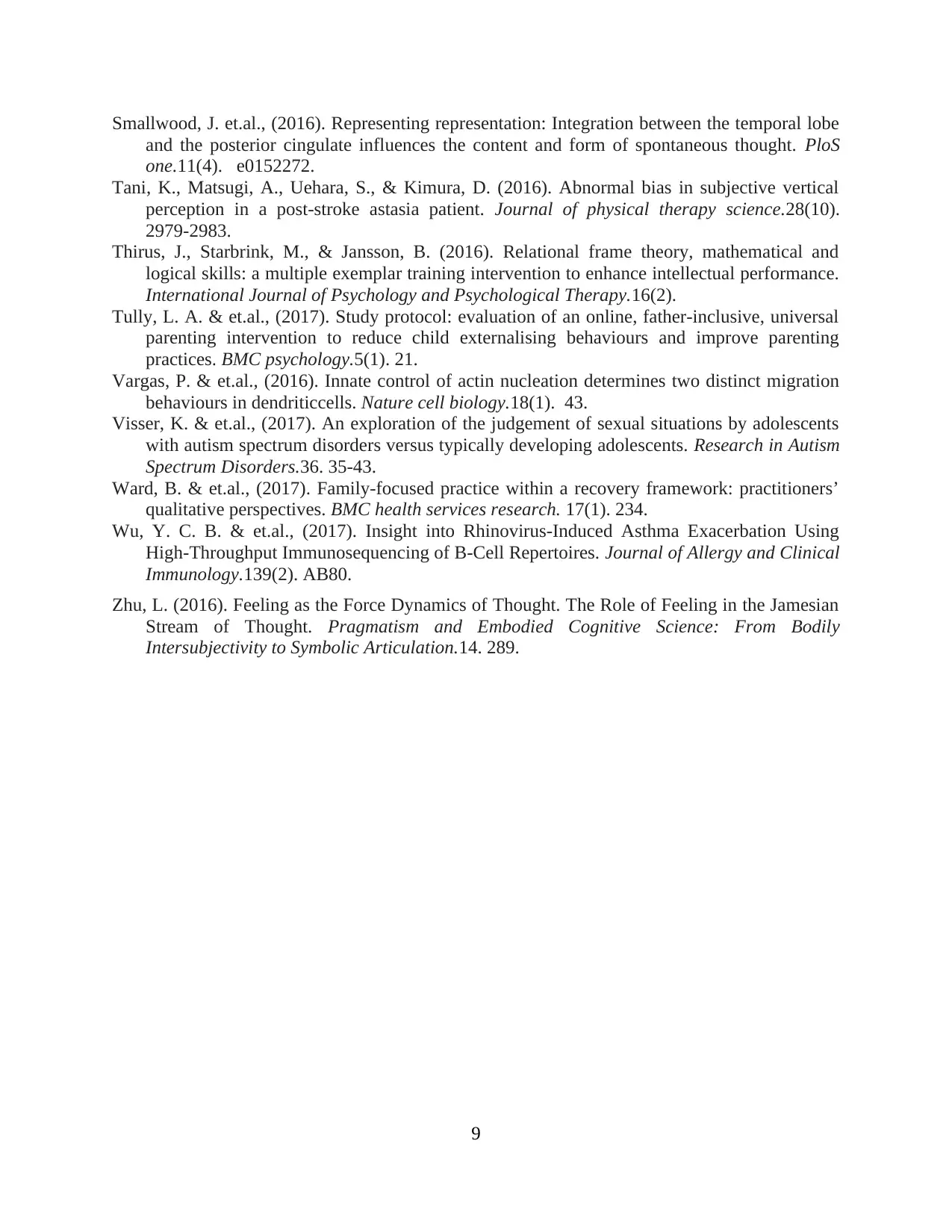
Smallwood, J. et.al., (2016). Representing representation: Integration between the temporal lobe
and the posterior cingulate influences the content and form of spontaneous thought. PloS
one.11(4). e0152272.
Tani, K., Matsugi, A., Uehara, S., & Kimura, D. (2016). Abnormal bias in subjective vertical
perception in a post-stroke astasia patient. Journal of physical therapy science.28(10).
2979-2983.
Thirus, J., Starbrink, M., & Jansson, B. (2016). Relational frame theory, mathematical and
logical skills: a multiple exemplar training intervention to enhance intellectual performance.
International Journal of Psychology and Psychological Therapy.16(2).
Tully, L. A. & et.al., (2017). Study protocol: evaluation of an online, father-inclusive, universal
parenting intervention to reduce child externalising behaviours and improve parenting
practices. BMC psychology.5(1). 21.
Vargas, P. & et.al., (2016). Innate control of actin nucleation determines two distinct migration
behaviours in dendriticcells. Nature cell biology.18(1). 43.
Visser, K. & et.al., (2017). An exploration of the judgement of sexual situations by adolescents
with autism spectrum disorders versus typically developing adolescents. Research in Autism
Spectrum Disorders.36. 35-43.
Ward, B. & et.al., (2017). Family-focused practice within a recovery framework: practitioners’
qualitative perspectives. BMC health services research. 17(1). 234.
Wu, Y. C. B. & et.al., (2017). Insight into Rhinovirus-Induced Asthma Exacerbation Using
High-Throughput Immunosequencing of B-Cell Repertoires. Journal of Allergy and Clinical
Immunology.139(2). AB80.
Zhu, L. (2016). Feeling as the Force Dynamics of Thought. The Role of Feeling in the Jamesian
Stream of Thought. Pragmatism and Embodied Cognitive Science: From Bodily
Intersubjectivity to Symbolic Articulation.14. 289.
9
and the posterior cingulate influences the content and form of spontaneous thought. PloS
one.11(4). e0152272.
Tani, K., Matsugi, A., Uehara, S., & Kimura, D. (2016). Abnormal bias in subjective vertical
perception in a post-stroke astasia patient. Journal of physical therapy science.28(10).
2979-2983.
Thirus, J., Starbrink, M., & Jansson, B. (2016). Relational frame theory, mathematical and
logical skills: a multiple exemplar training intervention to enhance intellectual performance.
International Journal of Psychology and Psychological Therapy.16(2).
Tully, L. A. & et.al., (2017). Study protocol: evaluation of an online, father-inclusive, universal
parenting intervention to reduce child externalising behaviours and improve parenting
practices. BMC psychology.5(1). 21.
Vargas, P. & et.al., (2016). Innate control of actin nucleation determines two distinct migration
behaviours in dendriticcells. Nature cell biology.18(1). 43.
Visser, K. & et.al., (2017). An exploration of the judgement of sexual situations by adolescents
with autism spectrum disorders versus typically developing adolescents. Research in Autism
Spectrum Disorders.36. 35-43.
Ward, B. & et.al., (2017). Family-focused practice within a recovery framework: practitioners’
qualitative perspectives. BMC health services research. 17(1). 234.
Wu, Y. C. B. & et.al., (2017). Insight into Rhinovirus-Induced Asthma Exacerbation Using
High-Throughput Immunosequencing of B-Cell Repertoires. Journal of Allergy and Clinical
Immunology.139(2). AB80.
Zhu, L. (2016). Feeling as the Force Dynamics of Thought. The Role of Feeling in the Jamesian
Stream of Thought. Pragmatism and Embodied Cognitive Science: From Bodily
Intersubjectivity to Symbolic Articulation.14. 289.
9
1 out of 11
Related Documents
Your All-in-One AI-Powered Toolkit for Academic Success.
+13062052269
info@desklib.com
Available 24*7 on WhatsApp / Email
![[object Object]](/_next/static/media/star-bottom.7253800d.svg)
Unlock your academic potential
Copyright © 2020–2025 A2Z Services. All Rights Reserved. Developed and managed by ZUCOL.




